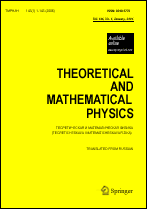|
This article is cited in 116 scientific papers (total in 116 papers)
Ten years of the analytic perturbation theory in QCD
D. V. Shirkova, I. L. Solovtsovab
a Joint Institute for Nuclear Research, Bogoliubov Laboratory of Theoretical Physics
b International Centre of Advanced Research, P. Sukhoi Gomel State Technical University
Abstract:
The renormalization group method allows improving the properties of the QCD
perturbative power series in the ultraviolet region. But it ultimately leads
to unphysical singularities of observables in the infrared domain.
The analytic perturbation theory is the next step in improving the perturbative
expansions. Specifically, it involves an additional analyticity requirement
based on the causality principle and implemented in the Källen–Lehmann and
Jost–Lehmann representations. This approach eliminates spurious
singularities of the perturbative power series and enhances the stability of
the series with respect to both higher-loop corrections and the choice of
the renormalization scheme. This paper is an overview of the basic stages in
developing the analytic perturbation theory in QCD, including its recent
applications to describing hadronic processes.
Keywords:
nonanalyticity in α, causality, Källen–Lehmann representation.
Received: 22.08.2006
Citation:
D. V. Shirkov, I. L. Solovtsov, “Ten years of the analytic perturbation theory in QCD”, TMF, 150:1 (2007), 152–176; Theoret. and Math. Phys., 150:1 (2007), 132–152
Linking options:
https://www.mathnet.ru/eng/tmf5971https://doi.org/10.4213/tmf5971 https://www.mathnet.ru/eng/tmf/v150/i1/p152
|


| Statistics & downloads: |
| Abstract page: | 1053 | | Full-text PDF : | 366 | | References: | 90 | | First page: | 7 |
|




 Contact us:
Contact us: Terms of Use
Terms of Use
 Registration to the website
Registration to the website Logotypes
Logotypes








 Citation in format
Citation in format 
